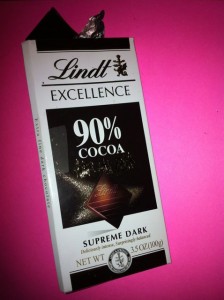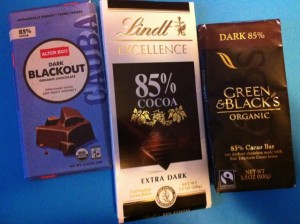One of the most common “cheats” people sneak into the paleo diet is dark chocolate. When very pure (85% cacao, and ideally no dairy or soy) it’s arguably pretty harmless and may offer antioxidant and other benefits. But with so many choices out there, which is best? Never fear; I’ve accepted the burden of doing some of the sifting and winnowing for you. Thank me later.
Of the ten bars I tested for this article, my overall favorite is Lindt Excellence 90% Cocoa Supreme Dark. I agree with its “Deliciously intense, Surprisingly balanced” tag line, and I’m quite impressed by the smooth texture and lack of burnt or bitter notes present in even 85% blends from most other brands. Though there is a warning that it may contain traces of peanuts, soy, tree nuts or milk, listed ingredients are only: chocolate, cocoa butter, cocoa powder processed with alkali, sugar, and bourbon vanilla beans. A 40 gram serving has 240 calories, 22 grams of fat, 12 grams of carbohydrate of which 3 grams are sugars.
Some notable runners up, fine choices all, include Alter Eco Dark Blackout, Lindt Excellence 85% Cocoa Extra Dark, and Green & Black’s Dark 85%. Lindt again wins the taste profile in my opinion, as I found the Alter Eco slightly burnt tasting and the G&B a tad sour. Note that all of these taste elements are both subjective- and subject to change with different batches. Also note that the bitterness of less-processed cocoa often indicates greater presence of beneficial compounds. Unlike Lindt, the Alter Eco and Green & Black’s (actually a Kraft Foods brand) both claim organic and fair trade status. The Blackout bar lists cocoa liquor as its first ingredient, rather than chocolate. I wonder if this explains its unusually high iron content of 39% per 40 gram serving, vs. 25% for Lindt and only 6% for G&B. Other macronutrient numbers are about as you’d expect from an 85% chocolate bar. (See table.)
The next tier includes Ghirardelli Intense Dark Midnight Reverie 86% Cacao, Endangered Species 88% Dark Chocolate, and Equal Exchange 80% Extra Dark Panama Chocolate. I would consider these decent “second choices” but not worth seeking out on their own. The first because it contains milk fat and soy lecithin, the second soy lecithin only, and the third because it’s only 80% cacao. The Endangered Species is, however, specifically labeled gluten free (though I suspect most chocolate actually is anyway) and the Equal Exchange is organic. The Panama bar is also made with chocolate liquor and interestingly has a higher (35% in 37 grams) iron content. I’m not sure if it was this ingredient choice or simply slightly higher sugar content that made it the least bitter tasting of the three.
The bottom tier (for now– expect this article to be expanded and revised in the future as I force myself to continue taste testing) didn’t quite meet my standards for one reason or another but may be just right for some. Ghirardelli’s Semi-Sweet Premium Baking Bar (as far as I’m concerned any chocolate is “eating” chocolate– ask my wife) is delicious enough, but contains milk fat and soy. I don’t see a cacao percentage listed, but I’m pretty sure it’s south of my 85% target. Similarly, in addition to unnecessary soy the Delish Mid Knight bar from Walgreen’s is a bit too sweet to make the cut at just 70%. I’d like to see them add a soy-free 90% bar to their price-friendly line, to compete with the Lindt offering. Finally, I really wanted to like Lily’s Dark Chocolate bar, proudly non-GMO and sweetened with stevia instead of sugar. The taste and texture were remarkable, and I’m sure the lack of sugar is a dream come true for certain people. However, I can’t consider it even “paleo-ish” when it includes not only milk fat and soy lecithin, but also inulin (a FODMAP that makes my tummy unhappy), dextrin, erythritol, and unspecified “natural flavors.” If they could work their magic without most of this they might shoot to the top of my list.
As I said, everyone’s needs and priorities differ. My opinions are offered only as a guideline. Below is a table that may help you compare other details from the bars I described. Please be aware that manufacturers often make changes, and I make no assurances that this data will be current when you read it. Do your own delicious homework to verify, and please let me know if you discover something special that I missed!
Lindt Excellence 90%Cocoa Supreme Dark
0-37466-04269-5 (USA) www.lindt.com
Chocolate, cocoa butter, cocoa powder processed with alkali, sugar, bourbon vanilla beans
“May contain traces of peanuts, tree nuts, milk, soybean”
| Serving Size | 40g | |
| Calories | 240 | |
| Fat Calories | 190 | |
| Total Fat | 22g | 34% |
| Saturated Fat | 13g | 65% |
| Total Carbohydrate | 12g | 4% |
| Dietary Fiber | 5g | 20% |
| Sugars | 3g | |
| Iron | 15% |
8-17670-01006-8 (Switzerland) www.alterecofoods.com
Organically Grown, Fairly Trade Certified, No Soy or Gluten Ingredients, No Emulsifiers, No Artificial Flavors, GMO-Free
Organic cocoa liquor, organic cocoa butter, organic raw cane sugar, organic vanilla
“Made on equipment shared with milk, hazelnuts, almonds and soy”
| Serving Size | 40g | |
| Calories | 240 | |
| Fat Calories | 190 | |
| Total Fat | 21g | 33% |
| Saturated Fat | 13g | 55% |
| Total Carbohydrate | 14g | 5% |
| Dietary Fiber | 5g | 19% |
| Sugars | 6g | |
| Iron | 39% |
Lindt Excellence 85% Cocoa Extra Dark 85%
0-37466-01645-0 (USA) www.lindt.com
Chocolate, cocoa powder, cocoa butter, demerara sugar, bourbon vanilla beans
“May contain traces of peanuts, tree nuts, milk, soybean”
| Serving Size | 40g | |
| Calories | 230 | |
| Fat Calories | 170 | |
| Total Fat | 18g | 28% |
| Saturated Fat | 11g | 55% |
| Total Carbohydrate | 15g | 5% |
| Dietary Fiber | 6g | 24% |
| Sugars | 5g | |
| Iron | 25% |
7-08656-10041-8 (Poland) www.greenandblacks.com/us
Fair Trade, Certified Organic
Organic chocolate, organic cocoa butter, organic raw cane sugar, organic vanilla extract
“Manufactured on equipment that processes milk, soy, tree nuts”
| Serving Size | 40g | |
| Calories | 250 | |
| Fat Calories | 180 | |
| Total Fat | 20g | 30% |
| Saturated Fat | 12g | 60% |
| Total Carbohydrate | 15g | 5% |
| Dietary Fiber | 4g | 16% |
| Sugars | 8g | |
| Iron | 6% |
Ghirardelli Midnight Reverie 86% Cacao Intense Dark
7-47599-60725-7 (USA) www.ghirardelli.com
Bittersweet chocolate (unsweetened chocolate, cocoa butter, sugar, milk fat, soy lecithin – an emulsifier), vanilla, natural flavor
“May contain tree nuts and milk”
| Serving Size | 45g | |
| Calories | 250 | |
| Fat Calories | 220 | |
| Total Fat | 25 | 38 |
| Saturated Fat | 15 | 74 |
| Total Carbohydrate | 15 | 5 |
| Dietary Fiber | 5 | 20 |
| Sugars | 5 | |
| Iron | 25 |
Organic chocolate liquor, organic raw cane sugar, organic cocoa butter, organic ground vanilla beans
“May contain traces of milk, peanuts, hazelnuts, almonds, cashews, pistachios & pecans”
| Serving Size | 37g | |
| Calories | 220 | |
| Fat Calories | 160 | |
| Total Fat | 18g | 27% |
| Saturated Fat | 11g | 54% |
| Total Carbohydrate | 14g | 5% |
| Dietary Fiber | 5g | 19% |
| Sugars | 7g | |
| Iron | 35% |
Endangered Species 88% Cocoa Dark Chocolate
0-37014-24247-8 (USA)
Certified Gluten-Free
Bittersweet chocolate (chocolate liquor, unbleached water-filtered beet sugar, soy lecithin, vanilla
“Produced on equipment that also processes product containing milk, peanuts and tree nuts.”
| Serving Size | 43g | |
| Calories | 210 | |
| Fat Calories | 180 | |
| Total Fat | 20g | 31% |
| Saturated Fat | 11g | 55% |
| Total Carbohydrate | 17g | 6% |
| Dietary Fiber | 6g | |
| Sugars | 5g | |
| Iron | 15% |
Semi-sweet chocolate (sugar, unsweetened chocolate, cocoa butter, milk fat, soy lecithin – an emulsifier, vanilla.)
“May contain tree nuts and milk”
| Serving Size | 42g | |
| Calories | 210 | |
| Fat Calories | 120 | |
| Total Fat | 14g | 21% |
| Saturated Fat | 8g | 41% |
| Total Carbohydrate | 26g | 9% |
| Dietary Fiber | 3g | 12% |
| Sugars | 20g | |
| Iron | 15% |
DeLISH 70% Cacao Mid Knight Premium German Dark
0-49022-65287-3 (Germany) www.walgreens.com
Cocoa Mass, Sugar, Cocoa Butter, Emulsifier: Soy Lecithin, Vanilla Extract
“May contain milk solids as well as traces of hazelnuts, almonds and gluten”
| Serving Size | 40g | |
| Calories | 230 | |
| Fat Calories | 160 | |
| Total Fat | 18g | 28% |
| Saturated Fat | 11g | 56% |
| Total Carbohydrate | 18g | 6% |
| Dietary Fiber | 4g | 16% |
| Sugars | 13g | |
| Iron | 15% |
Original Lily’s Dark Chocolate (55%)
8-56481-00300-5 (USA) www.lilyssweets.com
No Sugar Added, Non GMO, Sweetened With Stevia, Fair Trade Certified
Unsweetened Chocolate, Inulin, Dextrin (from Non-GMO Corn), Erythritol, Cocoa Butter, Milkfat, Soy Lecithin, Natural Flavors, Stevia Extract, Natural Vanilla
“Made on equipment shared with products containing milk, wheat, peanuts, tree nuts and soy.”







